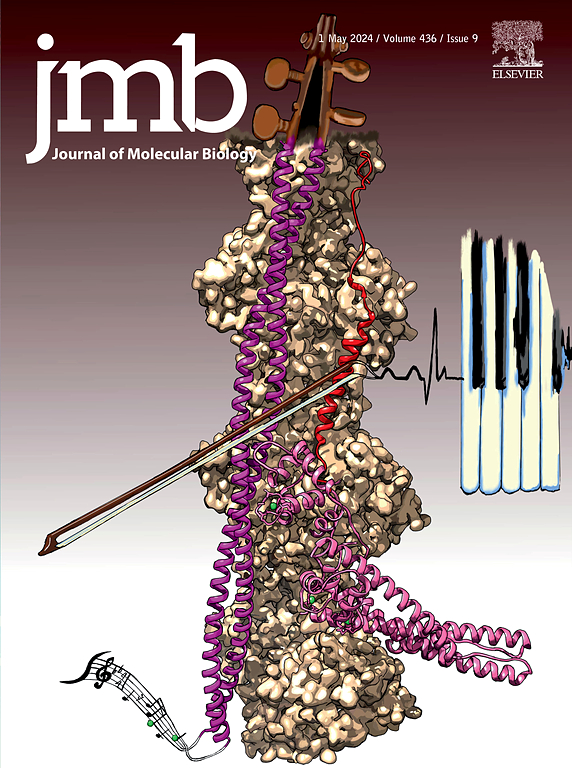NAIL-MS揭示了真核生物和原核生物在热应激反应中的关键tRNA U34修饰。
IF 4.5
2区 生物学
Q1 BIOCHEMISTRY & MOLECULAR BIOLOGY
引用次数: 0
摘要
全球变暖导致气温上升,需要在细胞水平上进行有机体适应。在逆境中维持蛋白质组完整性的一个潜在机制是tRNA修饰的适应性。虽然tRNA修饰重编程在化学应激条件下已经得到了很好的研究,但其在热应激中的作用仍不清楚。为了解决这一问题,我们比较分析了拟南芥、酿酒酵母、秀丽隐杆线虫、盘状盘基ostelium disideum和大肠杆菌在热胁迫下的tRNA修饰。我们在对照条件下使用同位素稀释质谱法评估了30个修饰核苷的丰度。与其他真核生物相比,拟南芥显示出相似的多样性和tRNA修饰的丰度,表明跨物种的保守性。在热胁迫下,tRNA的整体修饰水平基本稳定,二氢吡啶和n4 -乙酰胞苷等修饰没有明显变化。然而,每个生物体的1 - 4个修饰发生了变化,在位置34 (U34)的尿苷修饰是最显著的变化。在大肠杆菌和酿酒杆菌中进行的脉冲追踪nai - ms(核酸同位素标记耦合质谱)实验表明,U34修饰的变化不仅发生在已有的trna中,也发生在新转录的trna中。这些结果表明,现有的trna作为热应激的早期反应而适应,而新转录的trna被重新编程以确保在长时间高温下的长期生存。我们的研究结果强调了tRNA修饰重编程在热应激适应中的潜在作用。本文章由计算机程序翻译,如有差异,请以英文原文为准。

NAIL-MS Elucidates Crucial tRNA U34 Modifications in Response to Heat Stress across Eukaryotes and Prokaryotes
Global warming leads to rising temperatures, necessitating organismal adaptation at the cellular level. One potential mechanism for maintaining proteome integrity during stress is the adaptation of tRNA modifications. While tRNA modification reprogramming has been well-studied under chemical stressors, its role in heat stress remains unclear. To address this, we performed a comparative analysis of tRNA modifications in Arabidopsis thaliana, Saccharomyces cerevisiae, Caenorhabditis elegans, Dictyostelium discoideum, and Escherichia coli under heat stress. We assessed the abundance of 30 modified nucleosides using isotope dilution mass spectrometry under control conditions. A. thaliana showed a similar diversity and abundance of tRNA modifications compared to other eukaryotes, suggesting conservation across species. Under heat stress, overall tRNA modification levels were largely stable, with no significant changes in modifications such as dihydrouridine and N4-acetylcytidine. However, one to four modifications per organism were altered, with uridine modifications at position 34 (U34) being the most prominent change. Here, pulse-chase NAIL-MS (nucleic acid isotope labeling coupled mass spectrometry) experiments in E. coli and S. cerevisiae revealed that changes in U34 modifications occurred not only in pre-existing tRNAs but also in newly transcribed tRNAs. These results suggest that existing tRNAs adapt as an early response to heat stress, while newly transcribed tRNAs are reprogrammed to ensure long-term survival under prolonged heat. Our findings highlight the potential role of tRNA modification reprogramming in heat stress adaptation.
求助全文
通过发布文献求助,成功后即可免费获取论文全文。
去求助
来源期刊

Journal of Molecular Biology
生物-生化与分子生物学
CiteScore
11.30
自引率
1.80%
发文量
412
审稿时长
28 days
期刊介绍:
Journal of Molecular Biology (JMB) provides high quality, comprehensive and broad coverage in all areas of molecular biology. The journal publishes original scientific research papers that provide mechanistic and functional insights and report a significant advance to the field. The journal encourages the submission of multidisciplinary studies that use complementary experimental and computational approaches to address challenging biological questions.
Research areas include but are not limited to: Biomolecular interactions, signaling networks, systems biology; Cell cycle, cell growth, cell differentiation; Cell death, autophagy; Cell signaling and regulation; Chemical biology; Computational biology, in combination with experimental studies; DNA replication, repair, and recombination; Development, regenerative biology, mechanistic and functional studies of stem cells; Epigenetics, chromatin structure and function; Gene expression; Membrane processes, cell surface proteins and cell-cell interactions; Methodological advances, both experimental and theoretical, including databases; Microbiology, virology, and interactions with the host or environment; Microbiota mechanistic and functional studies; Nuclear organization; Post-translational modifications, proteomics; Processing and function of biologically important macromolecules and complexes; Molecular basis of disease; RNA processing, structure and functions of non-coding RNAs, transcription; Sorting, spatiotemporal organization, trafficking; Structural biology; Synthetic biology; Translation, protein folding, chaperones, protein degradation and quality control.
 求助内容:
求助内容: 应助结果提醒方式:
应助结果提醒方式:


